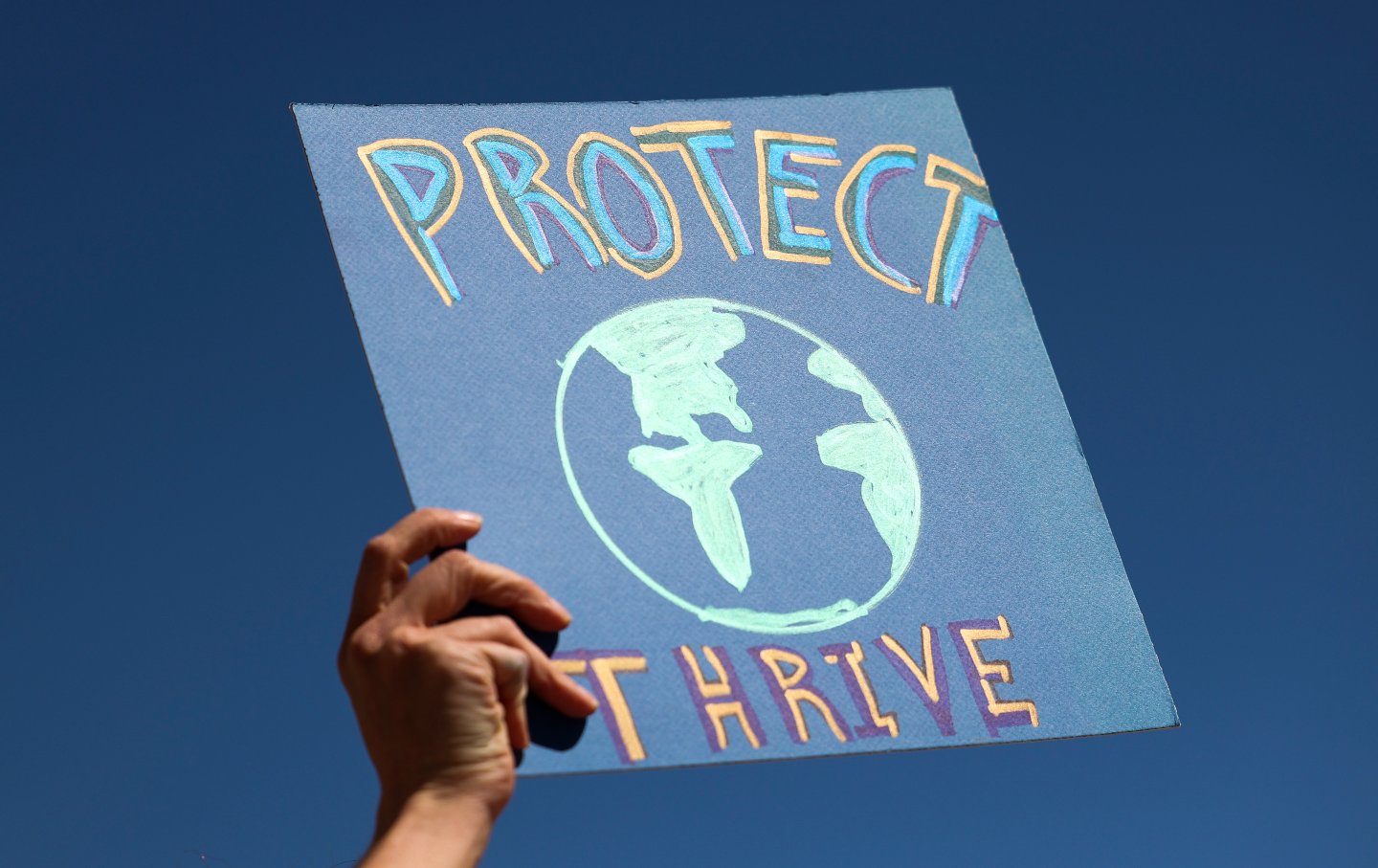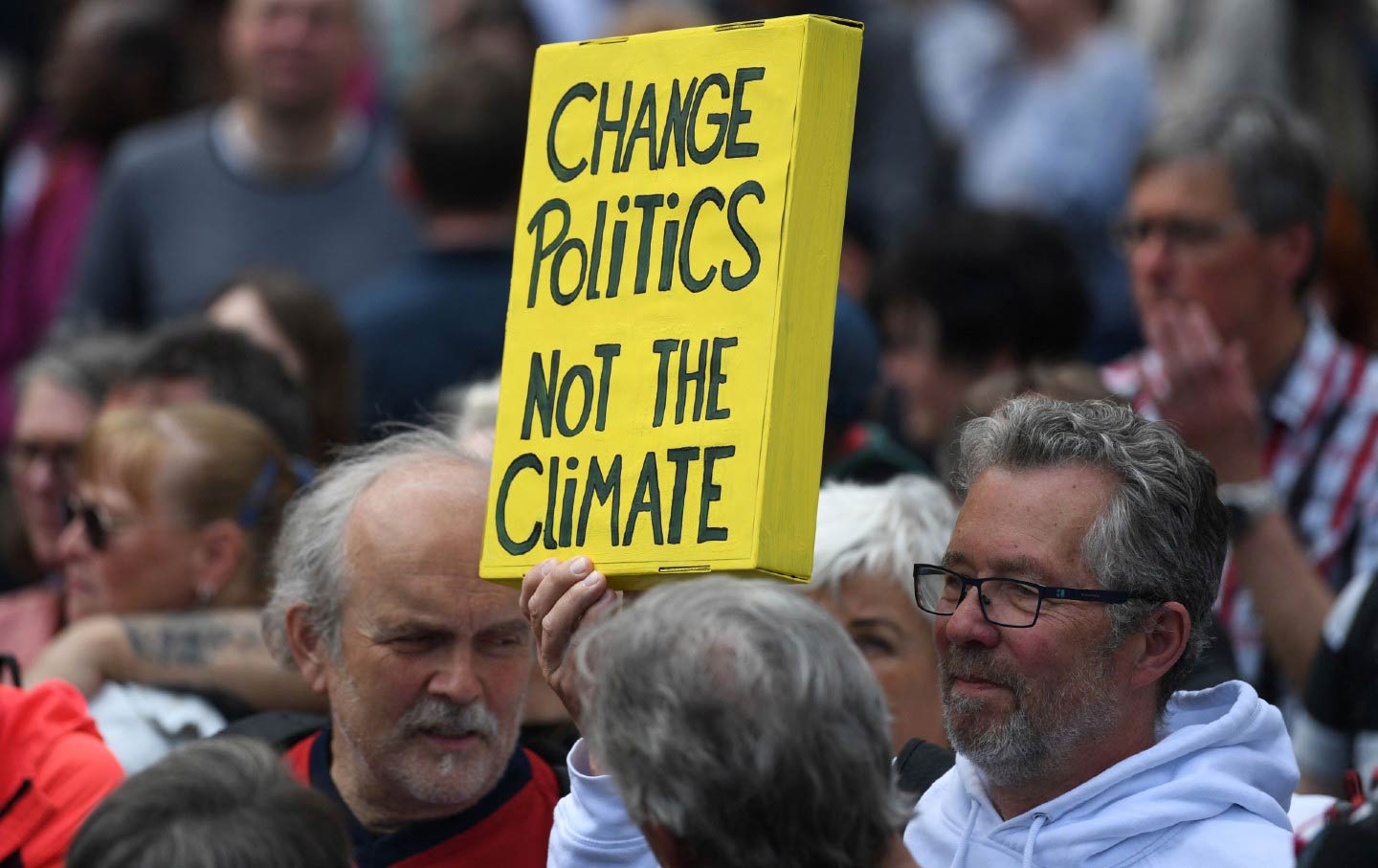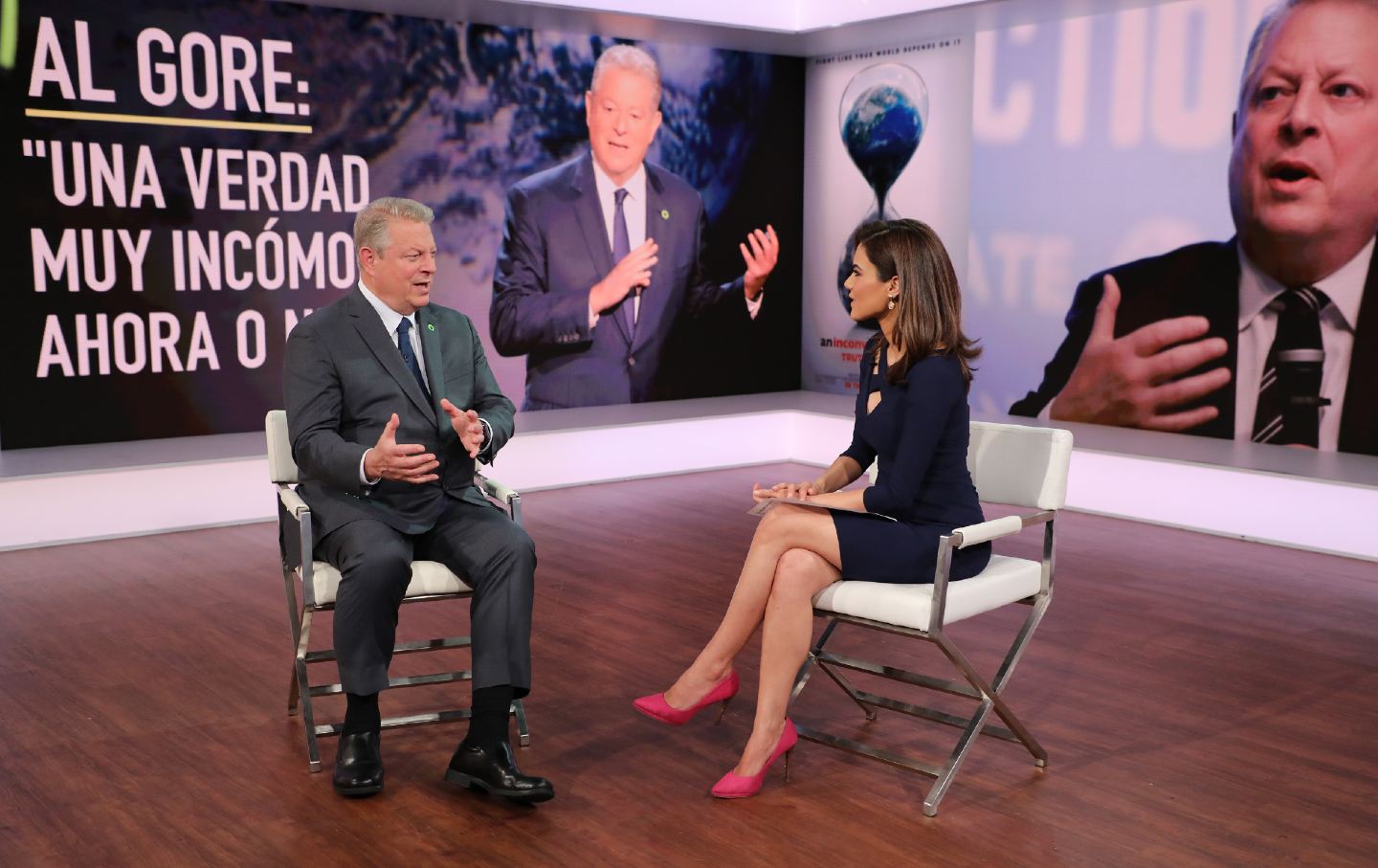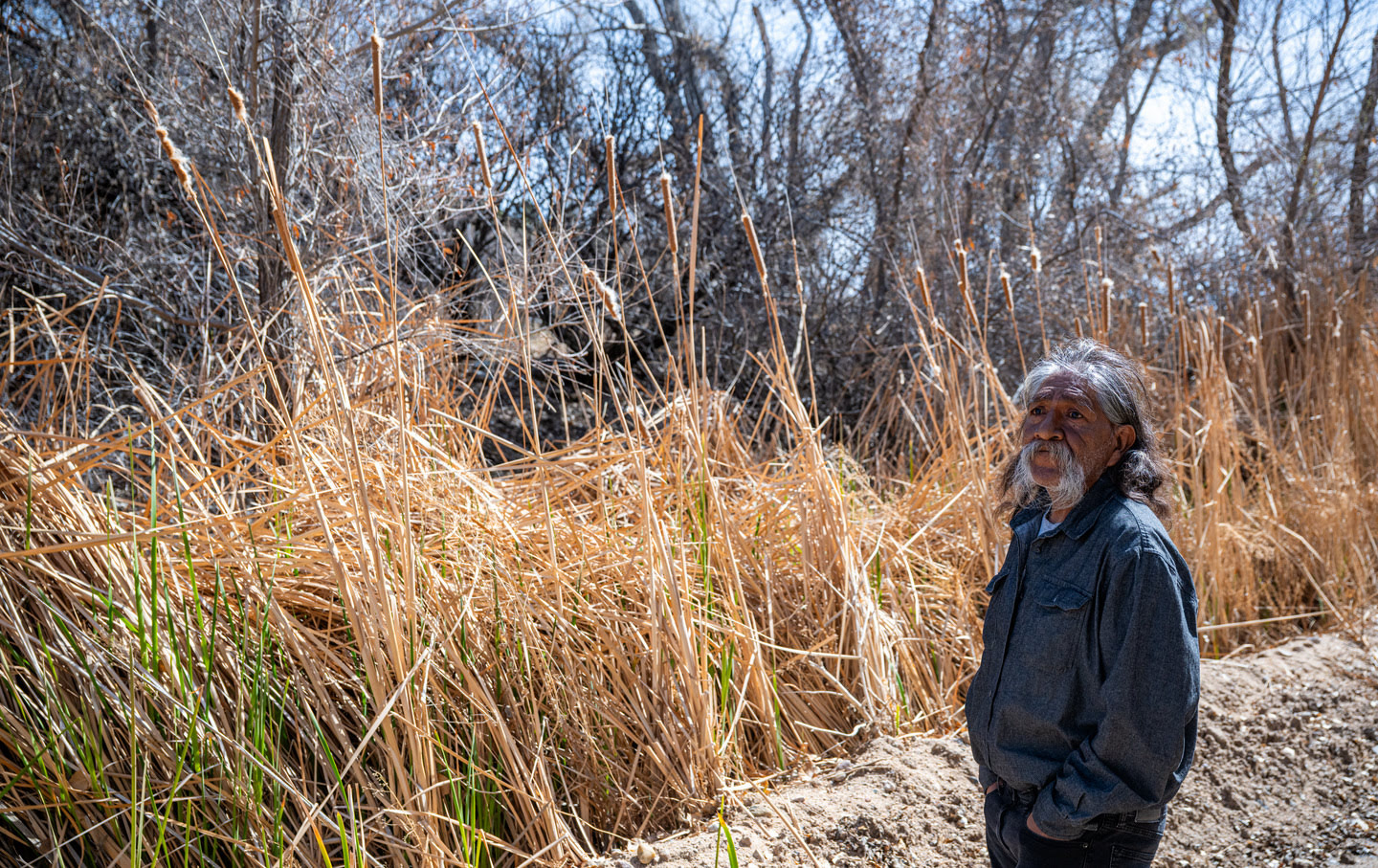Hydropower Won’t Stop the Climate Crisis—It Might Make It Worse
The dispute over Ethiopia’s enormous dam should be a warning of what the future holds on a hotter, drier planet.
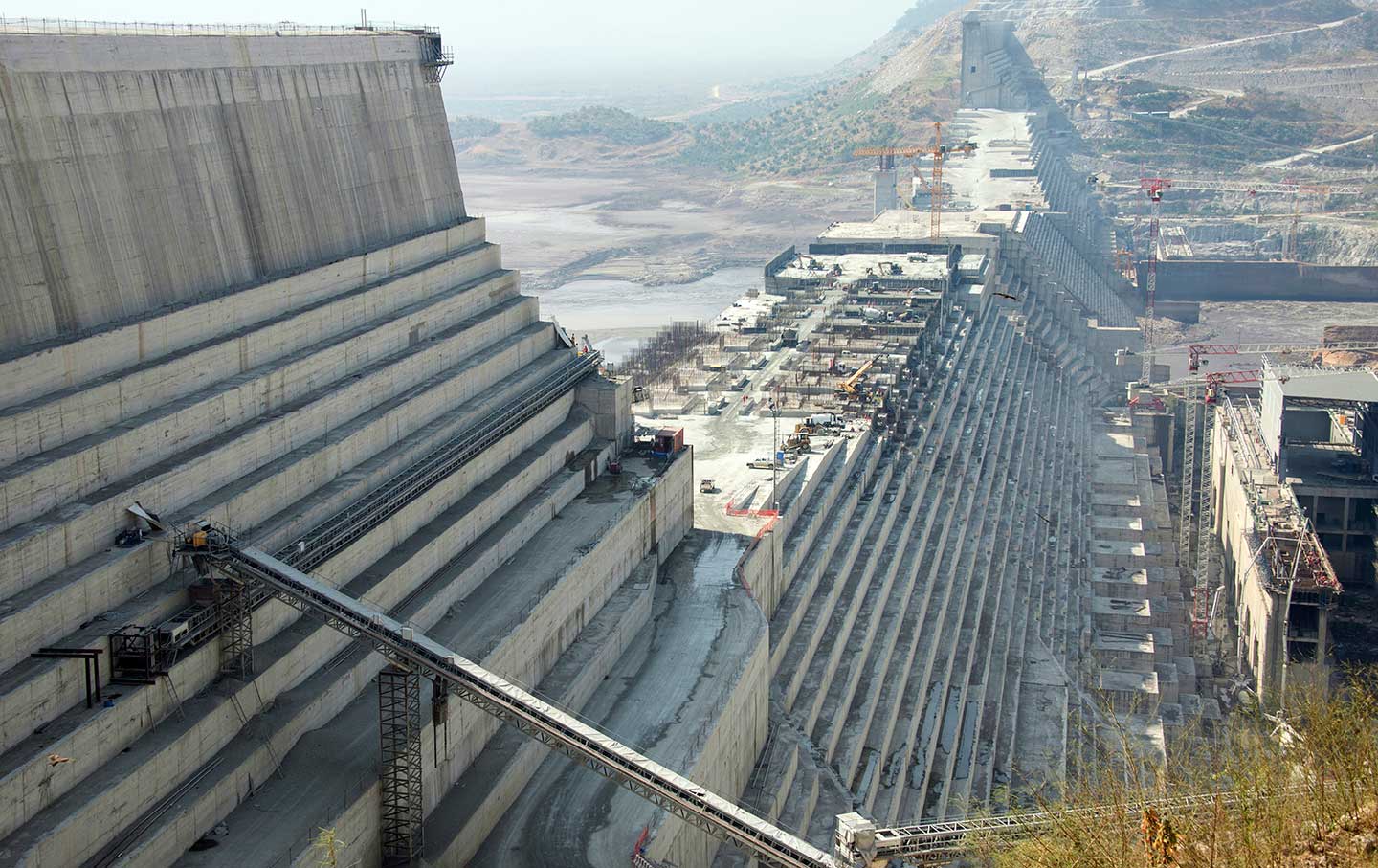
Machines stand on the construction site of the Grand Ethiopian Renaissance Dam in Guba, northwestern Ethiopia.
(Gioia Forster / AP)This article originally appeared at TomDispatch.com. To stay on top of important articles like these, sign up to receive the latest updates from TomDispatch.com.
We live in a world of dangerous, deadly extremes. Record-breaking heat waves, intense drought, stronger hurricanes, unprecedented flash flooding. No corner of the planet will be spared the wrath of human-caused climate change and the earth’s fresh water is already feeling the heat of this new reality. More than half of the world’s lakes and two-thirds of its rivers are drying up, threatening ecosystems, farmland, and drinking water supplies. Such diminishing resources are also likely to lead to conflict and even, potentially, all-out war.
“Competition over limited water resources is one of the main concerns for the coming decades,” warned a study published in Global Environmental Change in 2018. “Although water issues alone have not been the sole trigger for warfare in the past, tensions over freshwater management and use represent one of the main concerns in political relations between…states and may exacerbate existing tensions, increase regional instability and social unrest.”
The situation is beyond dire. In 2023, it was estimated that upwards of three billion people, or more than 37 percent of humanity, faced real water shortages, a crisis predicted to dramatically worsen in the decades to come. Consider it ironic then that, as water is disappearing, huge dams—more than 3,000 of them—that require significant river flow to operate are now being built at an unprecedented pace globally. Moreover, 500 dams are being constructed in legally protected areas like national parks and wildlife reserves. There was a justification for this, claimed the UN’s Intergovernmental Panel on Climate Change (IPCC) some years ago. Such projects, it believed, would help battle climate change by curbing carbon dioxide emissions while bringing electricity to those in the greatest of need.
“[Hydropower] remains the largest source of renewable energy in the electricity sector,” the IPCC wrote in 2018. “Evidence suggests that relatively high levels of deployment over the next 20 years are feasible, and hydropower should remain an attractive renewable energy source within the context of global [greenhouse gas] mitigation scenarios.”
The IPCC acknowledged that unceasing droughts impact stream flow and that climate change is unpredictably worsening matters. Yet its climate experts still contended that hydropower could be a crucial part of the world’s energy transition, arguing that an electric dam will produce seemingly endless energy. At the same time, other renewable sources like wind and solar power have their weather- and sunlight-bound limitations.
A Crack in the Dam Logic
Well-intentioned as it may have been, it’s now far clearer that there is a crack in the IPCC’s appraisal. For one thing, recent research suggests that hydro-powered dams can create an alarming amount of climate-altering greenhouse gas emissions. Rotting vegetation at the bottom of such reservoirs, especially in warmer climates (as in much of Africa), releases significant amounts of methane, a devastating greenhouse gas, into the atmosphere.
“Most of this vegetation would have rotted anyway, of course. But, without reservoirs, the decomposition would occur mostly in the atmosphere or in well-oxygenated rivers or lakes,” explains Fred Pearce in the Independent. “The presence of oxygen would ensure the carbon in the plants formed carbon dioxide. But many reservoirs, particularly in the tropics, contain little oxygen. Under those anaerobic conditions, rotting vegetation generates methane instead.”
While CO2 also seriously harms the climate, methane emissions are far worse in the short term.
“We estimate that dams emit around 25 percent more methane by unit of surface than previously estimated,” says Bridget Deemer of the School of Environment at Washington State University in Vancouver, lead author of a highly cited study on greenhouse gas emissions from reservoirs. “Methane stays in the atmosphere for only around a decade, while CO2 stays several centuries, but over the course of 20 years, methane contributes almost three times more to global warming than CO2.”
And that’s hardly the only problem dams face in the 21st century. At the moment, Chinese financing is the most significant global driver of new hydropower construction. China has invested in the creation of at least 330 dams in 74 countries. Each project poses its own set of environmental quandaries. But above all, the heating of the planet—last year was the warmest in human history and January 2024 the hottest January on record—is making many of those investments look increasingly dubious. On this ever-hotter globe of ours, for instance, a drought in Ecuador has all too typically impacted the functionality of the Amaluza Dam on the Paute River, which provides 60 percent of that country’s electricity. Paute was running at 40 percent capacity recently as its river flow dwindled. Similarly, in southern Africa, water levels at the Kariba Dam’s reservoir, located between Zambia and Zimbabwe, have fluctuated drastically, impairing its ability to produce consistent energy.
“In recent years, drought intensified by climate change has caused reservoirs on all five continents to drop below levels needed to maintain hydroelectric production,” writes Jacques Leslie in Yale E360, “and the problem is bound to worsen as climate change deepens.”
Even in the United States, the viability of hydropower is an increasing concern. The Hoover Dam on the Colorado River, for example, has been impacted by years of drought. Water levels at its reservoir, Lake Mead, continue to plummet, raising fears that its days are numbered. The same is true for the Glen Canyon Dam, which also holds back the Colorado, forming Lake Powell. As the Colorado dries up, Glen Canyon may also lose its ability to produce electricity.
Driven by dwindling water resources, the global hydropower crisis has become a flashpoint in the far reaches of Northern Africa, where the creation of a giant dam could very well lead to a regional war and worse.
A Crisis on the Nile
The lifeblood of northeastern Africa, the Nile River, flows through 11 countries before emptying into the Mediterranean Sea. Measured at 6,650 kilometers, the Nile may be the longest river on Earth. For millennia, its meandering waters, which run through lush jungles and dry deserts, have been irrigating farmlands and providing drinking water for millions of people. Nearly 95 percent of Egypt’s 109 million people live within a few kilometers of the Nile. Arguably the most important natural resource in Africa, it’s now at the epicenter of a geopolitical dispute between Egypt, Ethiopia, and Sudan that’s brought those countries to the brink of military conflict.
Popular
“swipe left below to view more authors”Swipe →A major dam being built along the Blue Nile, the river’s main tributary, is upending the status quo in the region, where Egypt has long been the preeminent nation. The Grand Ethiopian Renaissance Dam (GERD for short) is to become one of the largest hydroelectric dams ever constructed, stretching more than 1,700 meters and standing 145 meters tall, a monument many will love and others despise.
There’s no question that Ethiopia needs the electricity GERD will produce. Nearly 45 percent of all Ethiopians lack regular power and GERD promises to produce upwards of 5.15 gigawatts of electricity. To put that in perspective, a single gigawatt would power 876,000 households annually in the United States. Construction on the dam, which began in 2011, was 90 percent complete by last August when it began producing power. In total, GERD’s cost is expected to eclipse $5 billion, making it the largest infrastructure project Ethiopia has ever undertaken and the largest dam on the African continent.
It will not only bring reliable power to that country but promises a culture shift welcomed by many. “Mothers who’ve given birth in the dark, girls who fetch wood for fire instead of going to school—we’ve waited so many years for this—centuries,” says Filsan Abdi of the Ethiopian Ministry of Women, Children, and Youth. “When we say that Ethiopia will be a beacon of prosperity, it starts here.”
While most Ethiopians may see the dam in a positive light, the downstream countries of Egypt and Sudan (itself embroiled in a devastating civil war) were never consulted, and their officials are indignant. The massive reservoir behind GERD’s gigantic cement wall will hold back 74 billion cubic meters of water. That means Ethiopia will have remarkable control over the flow of the Nile, giving its leaders power over how much access to water both Egyptians and Sudanese will have. The Blue Nile, after all, provides 59 percent of Egypt’s freshwater supply.
As it happens, fresh water in Egypt has long been growing scarcer and so the country’s leadership has taken the threat of GERD seriously for years. In 2012, for instance, Wikileaks obtained internal e-mails from the “global intelligence” firm Stratfor revealing that Egypt and Sudan were even then considering directing the Egyptian Special Forces to destroy the dam, still in the early stages of construction. “[We] are discussing military cooperation with Sudan,” a high-level Egyptian source was quoted as saying. While such a direct attack never transpired, Stratfor claimed that Egypt might once again lend support to “proxy militant groups against Ethiopia” (as it had in the 1970s and 1980s) if diplomacy were to hit a dead end.
Unfortunately, the most recent negotiations to calm the hostility around GERD have gone distinctly awry. Last April, the embittered Egyptians responded to the lack of any significant progress by conducting a three-day military drill with Sudan at a naval base in the Red Sea aimed at frightening Ethiopian officials. “All options are on the table,” warned Egyptian Foreign Minister Sameh Shoukry. “[All] alternatives remain available and Egypt has its capabilities.”
Seemingly unfazed by such military threats, Ethiopia plans to finish building the dam, claiming it will provide much-needed energy to impoverished Ethiopians and limit the country’s overall carbon footprint. “[GERD] represents a sustainable socio-economic project for Ethiopia: replacing fossil fuels and reducing CO2 emissions,” the Ethiopian embassy in Washington has asserted.
GERD, however, falls squarely into the category of being a major problem dam—and not just because it could lead to a bloody war in a region already in horrific turmoil. Once filled, its massive reservoir will cover a staggering 1,874 square kilometers, making it more than three-quarters the size of Utah’s Great Salt Lake (after it started to shrink).
Unfortunately, GERD never underwent a proper environmental impact assessment (EIA) despite being legally required to do so. No EIA was ever carried out because the notoriously corrupt Ethiopian government knew that the results wouldn’t be pleasing and was unwilling to let any roadblocks get in the way of the dam’s construction, something that became more obvious when upwards of 20,000 indigenous Gumuz and Berta natives began to be forced from their homes to make way for the monstrous dam.
Publicly coming out against the dam has proven a risky business. Employees of International Rivers, a nonprofit that advocates for people endangered by dams, have been harassed and received death threats in response to their opposition. Prominent Ethiopian journalist Reeyot Alemu, a critic of the dam and the government’s actions concerning it, was imprisoned for more than four years under draconian anti-terrorism laws.
Electric Water Wars
While GERD has created a dicey conflict, it also has international ramifications. China, which has played such a pivotal role in bankrolling hydropower projects globally in these years, has provided $1.2 billion to help the Ethiopians build transmission lines from the dam to nearby towns. Since it has also heavily invested in Egypt, it’s well-positioned, if any country is, to help navigate the GERD dispute.
Military analysts in the United States argue that China’s involvement with the dam is part of a policy meant to put the US at a distinct disadvantage in the race to exploit Africa’s abundant rare earth minerals from the cobalt caverns of the Congo to the vast lithium deposits in Ethiopia’s hinterlands. China, the world’s “largest debt collector,” has indeed poured money into Africa. As of 2021, it was that continent’s largest creditor, holding 20 percent of its total debt. The growth of Chinese influence internationally and in Africa—it has large infrastructure projects in 35 African countries—is crucial to understanding the latest version of the globe’s imperial geopolitics.
Most of China’s African ventures are connected to Beijing’s “Belt and Road Initiative,” a program of this century to fund infrastructure deals across Eurasia and Africa. Its economic ties to Africa began, however, with Chinese leader Mao Zedong’s push in the 1950s and 1960s for an “Afro-Asian” alliance that would challenge Western imperialism.
So many decades later, the idea of such an alliance plays second fiddle to China’s global economic desires, which, like so many past imperial projects in Africa, have significant downsides for those on the receiving end. Developing countries desperately need capital, so they’re willing to accept rigid terms and conditions from China, even if they represent the latest version of the century’s old colonialism and neo-colonialism that focused on controlling the continent’s rich resources. This is certainly true in the case of China’s hydropower investments in places like Ghana’s Bui Dam and the Congo River Dam in the Republic of Congo, where multibillion-dollar loans are backed by Congo’s crude oil and Ghana’s cocoa crops.
In 2020, the United States belatedly inserted itself into the GERD feud, threatening to cut $130 million in aid for Ethiopia’s anti-terrorism efforts. The Ethiopians believed it was related to the dam controversy, as they also did when, in June 2023, the Biden administration directed USAID to halt all food assistance to the country (upwards of $2 billion), claiming it wasn’t reaching Ethiopians, only to reverse course months later.
The dispute over Ethiopia’s enormous dam should be a warning of what the future holds on a hotter, drier planet, where the rivers that feed dams like GERD are drying up while the superpowers continue to jockey for position, hoping to control what remains of the world’s resources. Hydropower won’t help solve the climate crisis, but new dam projects may lead to war over one thing key to our survival—access to fresh, clean water.
Hold the powerful to account by supporting The Nation
The chaos and cruelty of the Trump administration reaches new lows each week.
Trump’s catastrophic “Liberation Day” has wreaked havoc on the world economy and set up yet another constitutional crisis at home. Plainclothes officers continue to abduct university students off the streets. So-called “enemy aliens” are flown abroad to a mega prison against the orders of the courts. And Signalgate promises to be the first of many incompetence scandals that expose the brutal violence at the core of the American empire.
At a time when elite universities, powerful law firms, and influential media outlets are capitulating to Trump’s intimidation, The Nation is more determined than ever before to hold the powerful to account.
In just the last month, we’ve published reporting on how Trump outsources his mass deportation agenda to other countries, exposed the administration’s appeal to obscure laws to carry out its repressive agenda, and amplified the voices of brave student activists targeted by universities.
We also continue to tell the stories of those who fight back against Trump and Musk, whether on the streets in growing protest movements, in town halls across the country, or in critical state elections—like Wisconsin’s recent state Supreme Court race—that provide a model for resisting Trumpism and prove that Musk can’t buy our democracy.
This is the journalism that matters in 2025. But we can’t do this without you. As a reader-supported publication, we rely on the support of generous donors. Please, help make our essential independent journalism possible with a donation today.
In solidarity,
The Editors
The Nation


